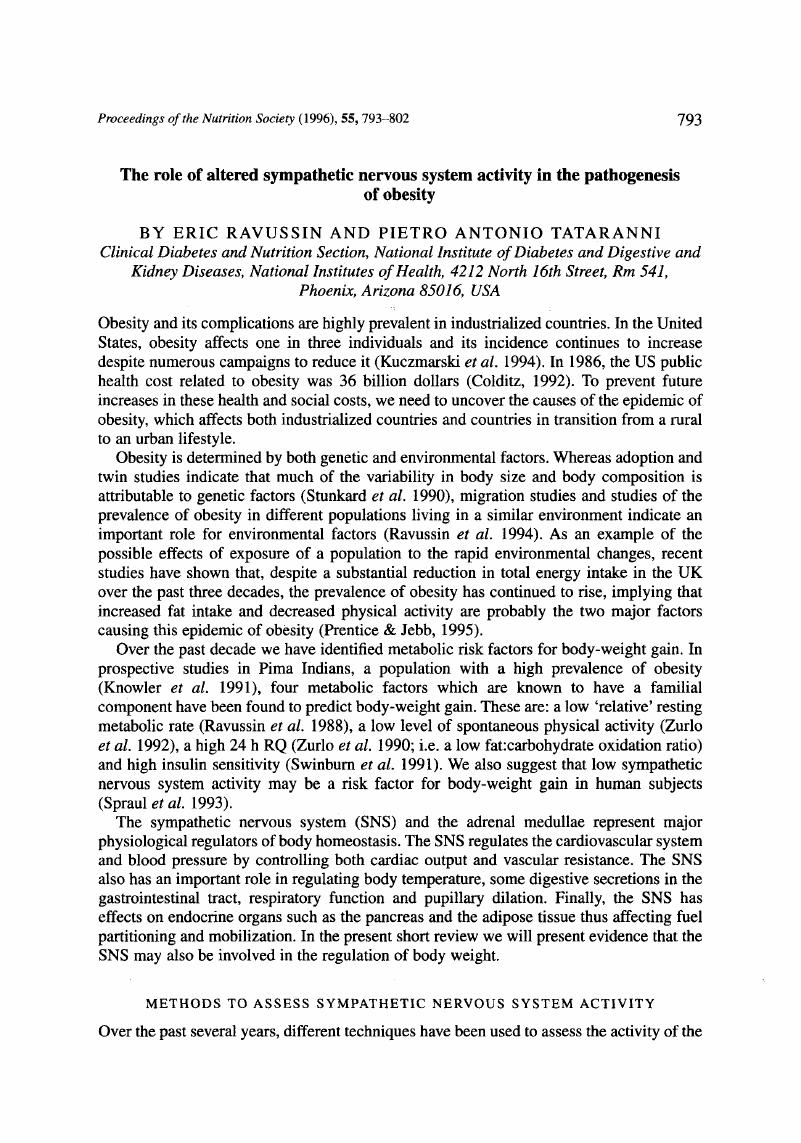Crossref Citations
This article has been cited by the following publications. This list is generated based on data provided by Crossref.
Gallagher, Dympna
Belmonte, Daniel
Deurenberg, Paul
Wang, Zimian
Krasnow, Norman
Pi-Sunyer, F. Xavier
and
Heymsfield, Steven B.
1998.
Organ-tissue mass measurement allows modeling of REE and metabolically active tissue mass.
American Journal of Physiology-Endocrinology and Metabolism,
Vol. 275,
Issue. 2,
p.
E249.
Hills, Andrew P.
and
Byrne, Nuala M.
1998.
Exercise prescription for weight management.
Proceedings of the Nutrition Society,
Vol. 57,
Issue. 01,
p.
93.
Schrauwen, Patrick
Walder, Ken
and
Ravussin, Eric
1999.
Human Uncoupling Proteins and Obesity.
Obesity Research,
Vol. 7,
Issue. 1,
p.
97.
Levine, James A.
Nygren, Jonas
Short, Kevin R.
and
Nair, K. Sreekumaran
2003.
Effect of hyperthyroidism on spontaneous physical activity and energy expenditure in rats.
Journal of Applied Physiology,
Vol. 94,
Issue. 1,
p.
165.
Martins, Andréia C.P
Souza, Kléber L.A
Shio, Marina T
Mathias, Paulo C.F
Lelkes, Peter I
and
Garcia, Raúl M.G
2004.
Adrenal medullary function and expression of catecholamine-synthesizing enzymes in mice with hypothalamic obesity.
Life Sciences,
Vol. 74,
Issue. 26,
p.
3211.
Davy, Kevin P.
2004.
The global epidemic of obesity: Are we becoming more sympathetic?.
Current Hypertension Reports,
Vol. 6,
Issue. 3,
p.
241.
Levine, J. A.
and
Kotz, C. M.
2005.
NEAT – non‐exercise activity thermogenesis – egocentric & geocentric environmental factors vs. biological regulation.
Acta Physiologica Scandinavica,
Vol. 184,
Issue. 4,
p.
309.
Levine, J. A.
2007.
Nonexercise activity thermogenesis – liberating the life‐force.
Journal of Internal Medicine,
Vol. 262,
Issue. 3,
p.
273.
Butte, Nancy F.
Puyau, Maurice R.
Vohra, Firoz A.
Adolph, Anne L.
Mehta, Nitesh R.
and
Zakeri, Issa
2007.
Body Size, Body Composition, and Metabolic Profile Explain Higher Energy Expenditure in Overweight Children ,.
The Journal of Nutrition,
Vol. 137,
Issue. 12,
p.
2660.
Davy, Kevin P.
and
Orr, Jeb S.
2009.
Sympathetic nervous system behavior in human obesity.
Neuroscience & Biobehavioral Reviews,
Vol. 33,
Issue. 2,
p.
116.
Magee, Christopher A.
Huang, Xu-Feng
Iverson, Donald C.
and
Caputi, Peter
2010.
Examining the Pathways Linking Chronic Sleep Restriction to Obesity.
Journal of Obesity,
Vol. 2010,
Issue. ,
p.
1.
Andreazzi, Ana Eliza
Grassiolli, Sabrina
Marangon, Paula Beatriz
Martins, Adriana Gallego
de Oliveira, Júlio Cézar
Torrezan, Rosana
Gravena, Clarice
Garcia, Raúl Marcel González
and
de Freitas Mathias, Paulo Cezar
2011.
Impaired Sympathoadrenal Axis Function Contributes to Enhanced Insulin Secretion in Prediabetic Obese Rats.
Experimental Diabetes Research,
Vol. 2011,
Issue. ,
p.
1.
Sarigianni, Maria
Bekiari, Eleni
Tsapas, Apostolos
Konstantinidis, Diamantis
Kaloyianni, Martha
Koliakos, George
and
Paletas, Konstantinos
2011.
Effect of Epinephrine and Insulin Resistance on Human Monocytes Obtained From Lean and Obese Healthy Participants: A Pilot Study.
Angiology,
Vol. 62,
Issue. 1,
p.
38.
Clapham, John C.
2012.
Central control of thermogenesis.
Neuropharmacology,
Vol. 63,
Issue. 1,
p.
111.
Ludy, M.-J.
Moore, G. E.
and
Mattes, R. D.
2012.
The Effects of Capsaicin and Capsiate on Energy Balance: Critical Review and Meta-analyses of Studies in Humans.
Chemical Senses,
Vol. 37,
Issue. 2,
p.
103.
Scott, Karen A.
Melhorn, Susan J.
and
Sakai, Randall R.
2012.
Effects of Chronic Social Stress on Obesity.
Current Obesity Reports,
Vol. 1,
Issue. 1,
p.
16.
Rodrigues, Lénia
Mouta, Raquel
Costa, Ana Rodrigues
Pereira, Alfredo
Capela e Silva, Fernando
Amado, Francisco
Antunes, Célia M.
and
Lamy, Elsa
2015.
Effects of high-fat diet on salivary α-amylase, serum parameters and food consumption in rats.
Archives of Oral Biology,
Vol. 60,
Issue. 6,
p.
854.
Poekes, Laurence
Legry, Vanessa
Schakman, Olivier
Detrembleur, Christine
Bol, Anne
Horsmans, Yves
Farrell, Geoffrey C.
and
Leclercq, Isabelle A.
2017.
Defective adaptive thermogenesis contributes to metabolic syndrome and liver steatosis in obese mice.
Clinical Science,
Vol. 131,
Issue. 4,
p.
285.
Miller, Alison L.
Kaciroti, Niko
Sturza, Julie
Retzloff, Lauren
Rosenblum, Katherine
Vazquez, Delia M.
and
Lumeng, Julie C.
2017.
Associations between stress biology indicators and overweight across toddlerhood.
Psychoneuroendocrinology,
Vol. 79,
Issue. ,
p.
98.
Contreras, Raian E.
Gruber, Tim
González-García, Ismael
Schriever, Sonja C.
De Angelis, Meri
Mallet, Noemi
Bernecker, Miriam
Legutko, Beata
Kabra, Dhiraj
Schmidt, Mathias
Tschöp, Matthias H.
Gutierrez-Aguilar, Ruth
Mellor, Jane
García-Cáceres, Cristina
and
Pfluger, Paul T.
2024.
HDAC5 controls a hypothalamic STAT5b-TH axis, the sympathetic activation of ATP-consuming futile cycles and adult-onset obesity in male mice.
Molecular Metabolism,
Vol. 90,
Issue. ,
p.
102033.



